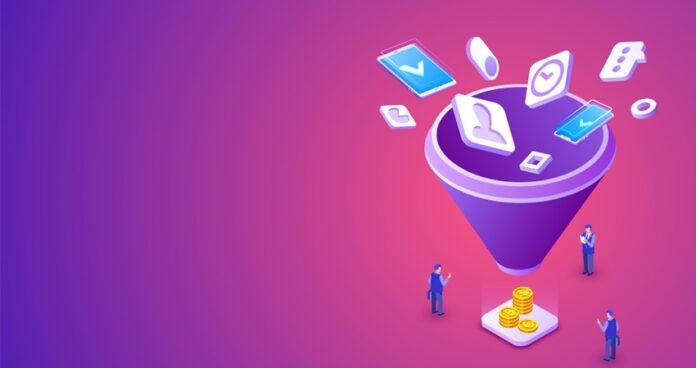The average sale takes eight touchpoints to close. Considering the amount of content your target customers engage with on a daily basis, the real number of interactions with your brand is almost certainly higher.
But what if you could shorten the sales cycle and increase conversion rates from each touchpoint with a few simple tweaks?
In this guide, we’ll show you everything you need to know about sales funnel optimization. That way, you can improve conversion rates, close more deals, and increase revenue.
What is sales funnel optimization?
Sales funnel optimization describes the process of analyzing, evaluating, and improving the effectiveness of your sales funnel. The goal is to identify areas where you can make changes that will lead to higher conversion rates from one stage of the funnel to the next.
Briefly, sales funnel optimization entails the following tasks:
- Analyzing existing performance data
- Identifying potential areas of improvement
- Making changes to the funnel
- Tracking new results and iterating as needed
Sales funnel optimization is a vital part of any successful marketing strategy. Without it, you won’t be able to accurately gauge the success of your campaigns or identify ways to increase leads and conversions.
The Stages of the Sales Funnel
Before you can optimize your sales funnel, it’s important to understand its structure. The typical sales funnel consists of five main stages:
- Awareness – This is when potential customers become aware of your product or service. Awareness-stage activities include garnering new impressions from ad campaigns, organic search, and content marketing.
- Interest – At this stage of the funnel, potential customers express their interest by taking some type of action. This could include signing up for a newsletter, downloading a white paper, or visiting your website.
- Evaluation – Here, potential customers compare your product or service to others. Ideally, this part of the sales funnel includes sales calls, webinars, and other buyer enablement content that helps your prospect pick the best possible solution.
- Purchase – Once a potential customer is convinced that your product or service is the right choice, they either convert into a paying customer or drop out of the sales process.
- Post-Purchase – After the purchase, your goal is to encourage customer loyalty and repeat sales. This could include offering discounts for future purchases, creating a rewards program, or setting up an email drip campaign with promotions and content tailored to customers who have already purchased from you.
Sales Funnel Optimization Strategies
Now that you understand the basic structure of a typical sales funnel, let’s look at some tactics to optimize each stage for maximum conversions.
Optimizing the Awareness Stage
Since Awareness is where the sales process begins, it’s important to make sure you are creating effective content that will grab potential customer attention. Here are a few tips:
- Use engaging visuals on your ads and website, such as videos, images, infographics, etc.
- Invest in A/B testing to determine which ad copy works best for different audiences.
- Promote your content on social media channels to reach a wider audience.
Since this stage is the first of many touchpoints, your goal isn’t to convert someone who views your awareness-stage collateral into a revenue-generating customer. All you want to do is get potential customers interested in learning more about your product or service (they’ll need more qualifications to determine their candidacy for your product).
Capitalizing on Interested Prospects
If you have customers who have already shown interest in your product (e.g., they signed up for your newsletter or requested a PDF of your product pricing), you already have the momentum to continue reaching out to them.
At this stage, the main goal is to nurture and qualify the prospect. Chances are, they aren’t ready to talk with a member of your team yet, so your goal should be to create the right content for them to research on their own.
This includes:
- Ebooks
- White papers
- Case studies
- Blog posts
- Product documentation
- Pricing information
- FAQs
By providing potential customers with these resources, you can gauge their interest and help them qualify themselves as a lead.
Making the Sale
By the time a prospect is ready to talk to a sales rep, they’ve already done considerable research. At this stage, the sales team should ask them questions around:
- Their business needs and goals
- Specific pain points or problems they think your product will solve
- Competitors they’re talking with
- Budgetary constraints
This information helps you sell more efficiently — if they don’t fit into the criteria of an ideal customer, you can spend more time on those that do and allow the customer to continue on the journey of finding the right solution. This is critical to sales funnel optimization because it helps you focus on qualified leads and close more deals.
Retaining Customers
Whether or not your customer gets value out of using your product is a huge part of customer retention. There are a few reasons they wouldn’t:
- They weren’t able to use your product correctly.
- You did a poor job qualifying them in the first place.
- Your product simply wasn’t the right fit for their needs.
To prevent this from happening, make sure your sales reps are asking lots of questions to qualify them as an ideal customer. Also, ensure that you have a post-purchase cycle set up to provide additional resources, support, and follow-up touchpoints to help them get the most out of your product.
Final Thoughts
Optimizing the sales funnel requires a combination of research, analysis, and experimentation. With the right approach, you can turn more leads into customers, close more deals, and grow revenue. By understanding the stages of the sales funnel and implementing effective internal optimization strategies, you can maximize conversions and drive better results for your business.

